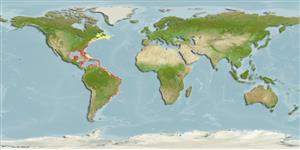Common names from other countries
Classification / Names / Names
Namen | Synonyme | Catalog of Fishes (gen., sp.) | ITIS | CoL | WoRMS
Environment: milieu / climate zone / depth range / distribution range
Ökologie
; tiefenbereich 0 - 75 m (Ref. 104365). Tropical; 70°N - 34°S, 98°W - 34°W
Western Atlantic. Tropical to polar climates of northern hemisphere.
Length at first maturity / Size / Gewicht / Alter
Maturity: Lm ? range ? - ? cmCommon length : 9.0 cm TL Männchen/unbestimmt; (Ref. 344)
Shell heavy, sturdy, inequivalve, with one valve slightly larger than the other. Anterior end short and rounded, posterior end longer and angled. Hinge straight. Sculpture of 25 to 27 radial ribs crossed by fine concentric lines prominent between ribs. Ribs never bifurcated. Umbones prominent, ligamental area large, hinge long, straight. Periostracum heavy. Colour: white; periostracum brown. It is consumed locally in soups amd chowders (Ref. 271).
Assumed total length is 9 cm (Ref. 344). Epibiotic (Ref. 104365). Found in soft bottoms (mud or sand), sometimes on seagrass environment at shallow intertidal depths (Ref. 271). Commensal with amphipods (Ref. 82302).
Life cycle and mating behavior
Geschlechtsreife | Fortpflanzung | Ablaichen | Eier | Fecundity | Larven
Members of the class Bivalvia are mostly gonochoric, some are protandric hermaphrodites. Life cycle: Embryos develop into free-swimming trocophore larvae, succeeded by the bivalve veliger, resembling a miniature clam.
Leal, J.H. 2003. (Ref. 344)
IUCN Rote Liste Status (Ref. 130435)
CITES Status (Ref. 108899)
Not Evaluated
Not Evaluated
Nutzung durch Menschen
| FishSource |
Tools
Mehr Information
Alter/GrößeWachstumLänge-GewichtLänge-LängeMorphologieLarvenDichte
Internet Quellen
Estimates based on models
Preferred temperature
(Ref.
115969): 22.9 - 28, mean 26.1 (based on 372 cells).
